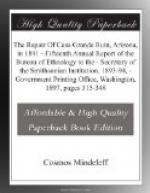Sir: Your request of August 7 for a report concerning a recommendation by Reverend Isaac T. Whittemore, under date of July 25, that provision be made for further protecting Casa Grande ruin, near Florence, Arizona, by the erection of a suitable roof, has been under consideration.
In many respects Casa Grande ruin is one of the most noteworthy relics of a prehistoric age and people remaining within the limits of the United States. It was discovered, already in a ruinous condition, by Padre Kino in 1694, and since that time it has been a subject of record by explorers and historians. Thus its history is exceptionally extended and complete. By reason of its early discovery and its condition when first seen by white men, it is known that Casa Grande is a strictly aboriginal structure; and archeologic researches in this country and Mexico afford grounds for considering it a typical structure for its times and for the natives of the southwestern region. Many other structures were mentioned or described by the Spanish explorers, but the impressions of these explorers were tinctured by previous experience in an inhospitable region, and their descriptions were tinged by the romantic ideas of the age; very few of these structures were within the limits of the United States, and nearly all of these situated in the neighboring republic of Mexico disappeared long ago; there is hardly a structure left, except Casa Grande ruin, by which the early accounts of Spanish explorers in North America can be checked and interpreted—none other of its class exists in the United States. Casa Grande ruin is, therefore, a relic of exceptional importance and of essentially unique character.
Unfortunately this structure, like others erected by the most advanced among the native races in the southwest, is of perishable material; it is built of adobe, or rather of cajon, i.e., of a puddled clay, molded into walls, dried in the sun. Such walls would stand a short time only in humid regions; but in the arid region the material is desiccated and baked under cloudless sky and sun for many months at a time, and becomes so hard as to resist, fairly, the rare storms of the region. It is by reason of climatal conditions that cajon and adobe have come into general use for building in southwestern United States, as in contiguous parts of Mexico; and it is by reason of the same conditions that a few of the ancient structures remain, and the best preserved of all is found in the Gila valley, one of the most desert regions on the western hemisphere. Yet the best of the cajon structures is perishable; so long as the roof remains and the summits of the walls are protected, disintegration proceeds slowly; but when the projecting roof is removed, the rare but violent storms attack the walls, and they are gradually channeled and gullied by the storm waters, while the exterior surface gradually disintegrates and falls away under the alternate wetting and drying.




